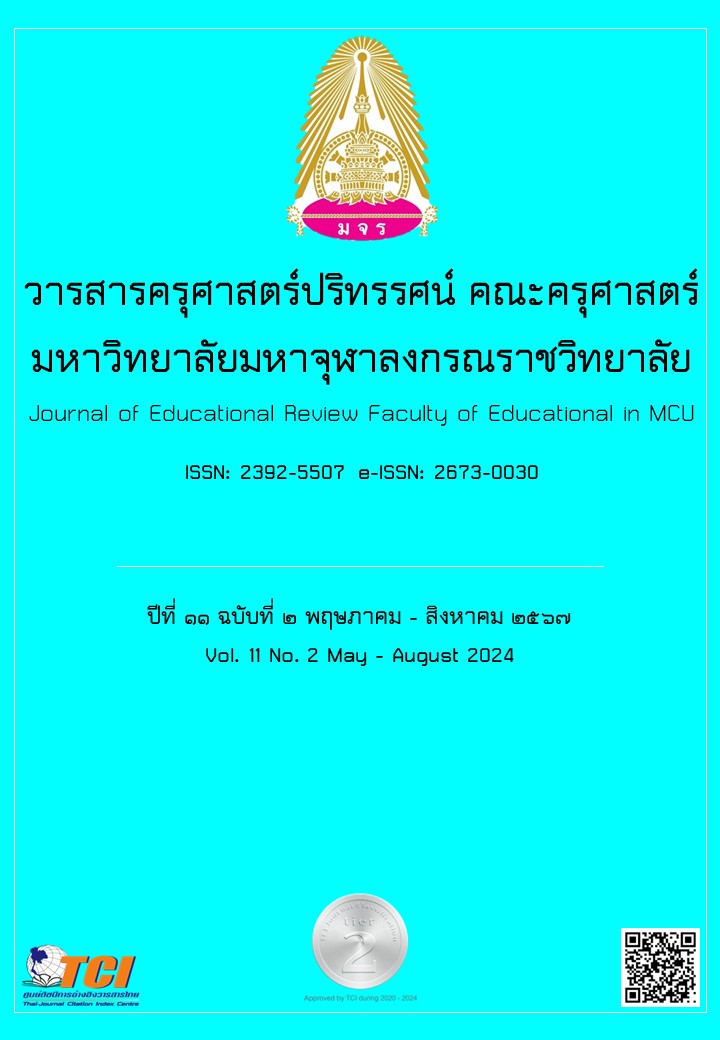THE CURRICULUM DEVELOPMENT OF ABHIDHAMMAPITAKA FOR LIFELONG LEARNING
Main Article Content
Abstract
This research article aimed to 1) study the current status, problems, causes and obstacles to Abhidhamma education of Buddhists in Thailand, 2) study the components of the development of an Abhidhamma curriculum structure for lifelong learning, and 3) develop and evaluate the curriculum structure for lifelong learning. This qualitative research used document study, participatory discussion, interviews and environmental analysis. There were 15 informants, 8 expert workshops, and 5 experts evaluated the curriculum suitability. Data were analyzed by content analysis. The results of the research found that 1) the problems, causes and obstacles to Abhidhamma education management as summarized from the environmental analysis (1) unclearly promoted as a policy of the Sangha, there were no agencies of the Supreme Sangha Council and government agencies related to Buddhism to provide care and support. (2) The administration of the school and academic administration in the school were not yet standardized. (3) The learning management did not divide the study sequence according to the age range of the students. The learning was mixed for each age group. (4) The learning media, supporting activities, and measurement and evaluation were not diverse. (5) The curriculum structure had not been developed according to the standard. 2) Components of the development of the Abhidhamma curriculum structure for lifelong learning consisted of 7 parts: (1) principles, (2) goals, (3) desired characteristics, (4) education level, (5) academic management consisting of learning management content, learning time management, learning media, learning enhancement activities, measurement and evaluation of learning outcomes. (6) teachers, (7) curriculum management and 3) the development of the Abhidhamma curriculum structure for lifelong learning as following: (1) principles of Abhidhamma study, (2) goals of Abhidhamma study, (3) desired characteristics of learners, (4) levels of Abhidhamma study, consisting of 9 parts in 3 age groups corresponding to early childhood to the elderly. (5) Abhidhamma academic administration useed the standard curriculum from Abhidhammajotika College as a model, classified into 9 parts, starting from Chula Abhidhammaka to Maha Abhidhamma, bachelor's, master's and doctoral degrees. Active learning management was used by providing media, supporting equipment, learning enhancement activities, and a variety of learning assessment and evaluation, using modern digital technology appropriate for the age to support. (6) Abhidhamma teachers were supported to develop knowledge, skills and experience continuously as a professional, (7) Curriculum management has been developed to have a system that met international standards and the results of the evaluation of the Abhidhamma curriculum structure for lifelong learning had been evaluated for suitability in terms of components, application, feasibility and overall beneficial use at a high level.
Article Details

This work is licensed under a Creative Commons Attribution-NonCommercial-NoDerivatives 4.0 International License.
ทัศนะและความคิดเห็นที่ปรากฏในบทความในวารสารฉบับนี้ถือเป็นความรับผิดชอบของผู้เขียนบทความนั้นเพียงผู้เดียว และไม่ถือเป็นทัศนะและความรับผิดชอบของกองบรรณาธิการ
กองบรรณาธิการขอสงวนสิทธิ์ในการคัดเลือกบทความลงตีพิมพ์และจะแจ้งให้เจ้าของบทความทราบหลังจากผู้ประเมินบทความตรวจอ่านบทความแล้ว
ต้นฉบับที่ได้รับการตีพิมพ์ในวารสารครุศาสตร์ปริทรรศน์ คณะครุศาสตร์ มหาวิทยาลัยมหาจุฬาลงกรณราชวิทยาลัย ถือเป็นกรรมสิทธิ์ของคณะครุศาสตร์ มหาวิทยาลัยมหาจุฬาลงกรณราชวิทยาลัย ห้ามนำข้อความทั้งหมดหรือบางส่วนไปพิมพ์ซ้ำ เว้นเสียแต่ว่าจะได้รับอนุญาตจากมหาวิทยาลัยฯ เป็นลายลักษณ์อักษร
References
คุณานนต์ วิหคาภิรมย์. (2565). ปัจจัยที่เป็นอุปสรรคในการให้การศึกษาแก่เด็กนักเรียนไทย. วิทยานิพนธ์รัฐประศาสนศาสตรมหาบัณฑิต. จุฬาลงกรณ์มหาวิทยาลัย.
ธัญนันท์ เพชรรักษ์ และเอกรินทร์ สังข์ทอง. (2565). ปัญหา การสนับสนุนการเรียนรู้ และข้อเสนอแนะในการสนับสนุนการเรียนรู้ของโรงเรียนขยายโอกาส กลุ่มดินสอสี ในช่วงสถานการณ์การแพร่ระบาดของโรคติดเชื้อไวรัสโคโรนา 2019. Research and Development Journal Suan Sunandha Rajabhat University. 14(2). 1-13.
พระพรหมคุณาภรณ์ (ป. อ. ปยุตฺโต). (2551). พจนานุกรมพุทธศาสตร์ ฉบับประมวลศัพท์. กรุงเทพมหานคร: ธนธัชการพิมพ์.
พระพรหมคุณาภรณ์ (ป. อ. ปยุตฺโต). (2551). พจนานุกรมพุทธศาสตร์ ฉบับประมวลธรรม. พิมพ์ครั้งที่ 16. กรุงเทพมหานคร: เอส. อาร์. พริ้นติ้ง แมส โปรดักส์.
มหาจุฬาลงกรณราชวิทยาลัย. (2539). พระไตรปฎกภาษาไทย ฉบับมหาจุฬาลงกรณราชวิทยาลัย. กรุงเทพมหานคร: มหาจุฬาลงกรณราชวิทยาลัย.
ราชบัณฑิตยสถาน. (2552). พจนานุกรมศัพท์ศาสนาสากล อังกฤษ-ไทย ฉบับราชบัณฑิตยสถาน. พิมพ์ครั้งที่ 3. กรุงเทพมหานคร: ราชบัณฑิตยสถาน.
ศักดา ใจตรง. (2553). การบริหารหลักสูตรแกนกลางการศึกษาขั้นพื้นฐาน พุทธศักราช 2551 ของโรงเรียนต้นแบบการใช้หลักสูตรจังหวัดราชบุรี. วิทยานิพนธ์ศึกษาศาสตรมหาบัณฑิต. มหาวิทยาลัยศิลปากร.
สมพร หลิมเจริญ. (2552). การพัฒนาหลักสูตรเสริมเพื่อส่งเสริมความคิดสร้างสรรค์สำหรับนักเรียน ช่วงชั้นที่ 2. ดุษฎีนิพนธ์การศึกษาดุษฎีบัณฑิต. มหาวิทยาลัยศรีนครินทรวิโรฒ.
สำนักงานเลขาธิการสภาการศึกษ. (2563). อำนาจหน้าที่. แหล่งที่มา http://www.onec.go.th/index.php/page/category/CAT0001153 สืบค้น 4 มิ.ย. 2563.
สำนักงานเลขาธิการสภาการศึกษา กระทรวงศึกษาธิการ. (2563). สมองซีกขวา มีค่ามากกว่าที่คิด. กรุงเทพมหานคร: สำนักงานเลขาธิการสภาการศึกษา กระทรวงศึกษาธิการ.


